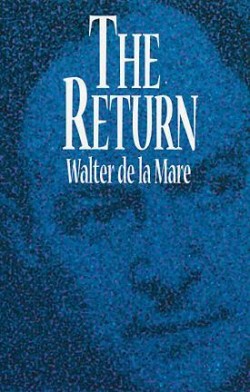 Early in his writing career Walter De la Mare (1873-1956)—poet-laureate of childhood, master of the subtle ghost story, and idiosyncratic anthologist—produced an eerie novel called The Return. Its theme is possession: a man falls asleep by a grave and discovers, upon waking, that he has been transformed into the image of a long-dead suicide.
Early in his writing career Walter De la Mare (1873-1956)—poet-laureate of childhood, master of the subtle ghost story, and idiosyncratic anthologist—produced an eerie novel called The Return. Its theme is possession: a man falls asleep by a grave and discovers, upon waking, that he has been transformed into the image of a long-dead suicide.
I don’t know much more about the plot, and even that summary might be slightly off, since only this week did I decide to read the novel. To do so, I first went rooting around in my basement until I’d unearthed the shelf containing a half dozen or so De la Mare titles. Upon closer inspection of these treasures, I discovered that my copy of The Return was a shabby ex-library first edition, published in 1910. Nearby I noticed an old Viking Portable anthology titled Six Novels of the Supernatural (1944) edited by Edward Wagenknecht. It included The Return.
A digression: Wagenknecht was a huge De la Mare admirer, especially enthusiastic about Memoirs of a Midget (1921), which he regarded as the greatest English novel of its time. (I’m not sure I’d disagree with him, even if nobody seems to read the book anymore: those interested can consult the essay on Memoirs of a Midget in my book Classics for Pleasure.) Born in 1900, Wagenknecht lived until 2004, publishing a book on Willa Cather when he was 94. I’ve sometimes wondered if he ever changed his mind about De la Mare or Memoirs of a Midget. I hope he didn’t. End of digression.
At all events, Six Novels of the Supernatural showcased The Return. Naturally, I opened the book, scanned the introduction, and, to my dismay, discovered that Wagenknecht had reprinted a “revised” edition of The Return published in 1922.
My old bookman’s heart almost broke.
I wanted to read my beat-up first edition, if only because this was the way the book initially appeared to the public and because this was the text awarded something called the Polignac Prize. The worn cover, the thick paper, the good printing, the slight foxing, the lending library stamps—all gave the scruffy volume a winningly dilapidated, properly romantic character, suitable for a novel about spiritual possession. The clean, neat text in the Viking Portable seemed antiseptic by comparison. It wouldn’t be half as much fun to encounter the story in such a format.
Still, that was the version I probably should read, right? But questions remained. Had De la Mare gone back to improve what he regarded as a juvenile effort? Or had he mucked about with the text to its detriment? And shouldn’t I follow his authorial wishes? Nonetheless, I had a vague memory that his children’s novel The Three Mulla-Mulgars (also 1910, a good year for De la Mare) had been slightly toned down, almost bowdlerized, when he republished it as The Three Royal Monkeys (1927). Could this be a similar case, and might it actually be better to read the unrevised text? Sigh. Perhaps one of my reference books could advise me about these arcane matters.
But E. F. Bleiler, in his Guide to Supernatural Fiction, merely noted, without comment, that De la Mare had revised The Return in 1922. I then consulted an essay on De la Mare by John Clute, our greatest living critic of science fiction and fantasy. Double whammy: Clute revealed that De la Mare had tinkered with The Return yet again in 1945, apparently still dissatisfied with its text. But were these changes significant? Clute didn’t say. Was I going to have to track down—somehow, somewhere—a copy of this 1945 edition?
Hoping to avoid this, I emailed Mark Valentine in England. Valentine edits Wormwood, a scholarly journal devoted to “literature of the fantastic, supernatural and decadent”; he also introduced Strangers and Pilgrims, a handsome volume of De la Mare’s ghost stories published by Tartarus Press. Had he ever compared the three editions? Alas, he had not. Stymied again.
At this point, I thought of L. W. Currey, the leading American dealer in first-edition science fiction, fantasy, and horror. I went to his website, clicked around until I found De La Mare, zeroed in on one of his several copies of The Return. And there, in his description of the book, was my answer: “The author revised the text in 1922, toning down the supernaturalism, and this text was the basis of reprints until the recent (1997) Dover reissue which utilized the text of the first edition.” Given Dover’s reversion to the 1910 edition, it would seem that critical opinion now favors that text. I could read my beat-up copy, after all.
Most sensible people, I’m sure, never experience such neurotic compulsions and fussy qualms. They pick up a book at the library or bookshop, or maybe they download its text from Project Gutenberg, and, without further ado, they read it. But, alas, I Am Not As Other Men. I like first editions, though I’ll sometimes settle for a later printing if it’s within a year or two of the book’s original publication date. Only these editions possess that distinctive aura of the original, a glamour that subsequent reissues can never recapture. That said, I do gravitate toward well printed, scholarly editions of certain classic texts, with lots of notes and a good bibliography. If I’m going to spend my life reading books, I want my experiences to be optimal.
Enough of this. With a burden lifted from my soul, I can now settle down and read, happily I hope, The Return. “The churchyard in which Arthur Lawford found himself wandering that mild and golden September afternoon was old, green, and refreshingly still …”

